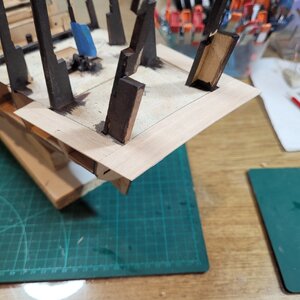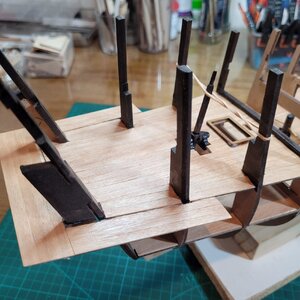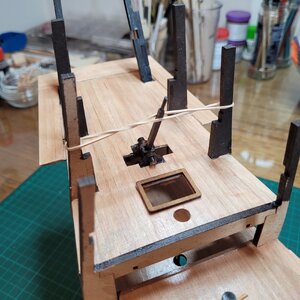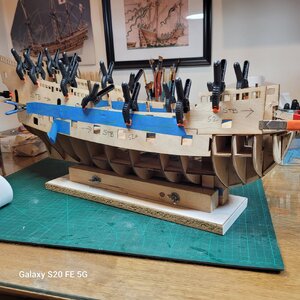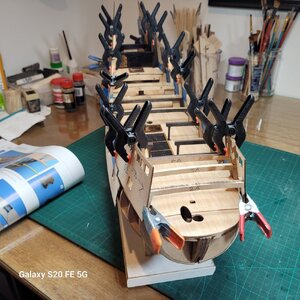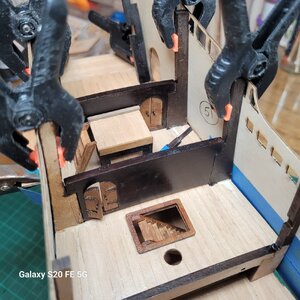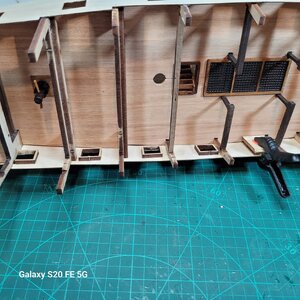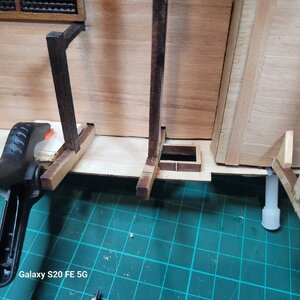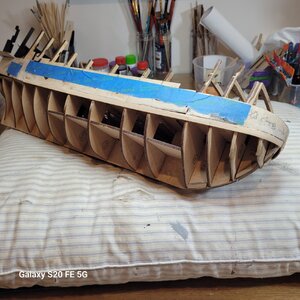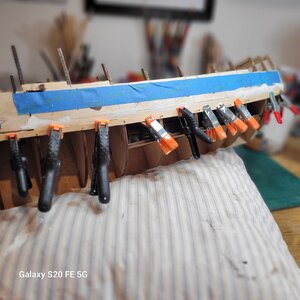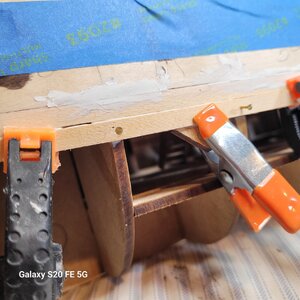Accidentally logged on with a disused signon..(Mindi) fixed now.
You are using an out of date browser. It may not display this or other websites correctly.
You should upgrade or use an alternative browser.
You should upgrade or use an alternative browser.
HMS Revenge 1577 by Amati , Victory Models
- Thread starter mallacoota
- Start date
- Watchers 12
-
- Tags
- amati revenge victory models
moved
The really fragile ones are the upper bulwarks where the openings are cut in aft, I have broken them multiple times during planking….
Ahhh...thanks for that Lou. Your comment is also exactly on the money for Mary Rose..the upper bulwarks there were parts from hell.
TIP.... They have you deck plank most parts before installation. Good. Except they have you plank 45 and 46 at the stern after installation and they are really awkward. I would definitely plank them before installing on the hull just like all the others. I cant see any reason to leave it until afterwards
progressing with the side panels and the cannons required before side fit.
Transom cannon... barrel just in place to help centre it
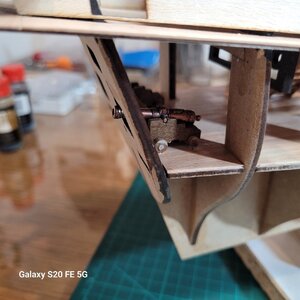
The stern quarter gun carraiges and ports get installed here. The position is hard up against a bulkhead so if you want to centralise the gun (as you do) then you need to
1. remove the wheels on the forward side of the carraige
2 put some packing under that side to maintain the height
3.Remove the forward part of the gunport installed on the side panel
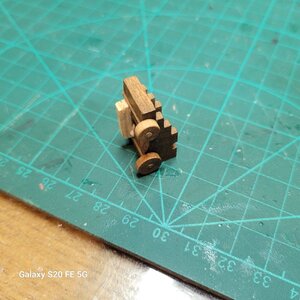
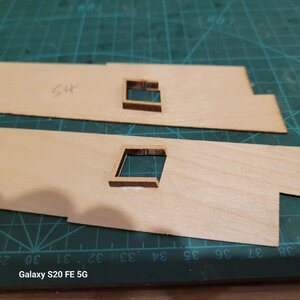
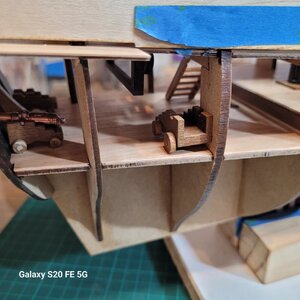
Transom cannon... barrel just in place to help centre it

The stern quarter gun carraiges and ports get installed here. The position is hard up against a bulkhead so if you want to centralise the gun (as you do) then you need to
1. remove the wheels on the forward side of the carraige
2 put some packing under that side to maintain the height
3.Remove the forward part of the gunport installed on the side panel



It is all going quite well but I have just made a discovery which has made me very very unhappy. I cannot believe Amati would do this, especially for a Victory series model costing just over $600aud. The top planking is not walnut or mahogany as I imagined, but rotten splintery tanganyika 1 x 5. I hate this variety of wood. Apart from the brittle nature of it and its propensity to splinter, it will need staining to stop the finished hull from looking a sickly tanganyika yellow.
Did I mention how PO'd I am...? I have always thought very well of Amati..not after this...I have quite a bit of spare wood but not enough of anything to do the whole hull with one product.
To be honest, I might just do the first layer to a "finished" standard as it is really good quality lime 2 x 5. Why would you provide a high quality 1st layer and rubbish for the second ..? Beats me.
Did I mention how PO'd I am...? I have always thought very well of Amati..not after this...I have quite a bit of spare wood but not enough of anything to do the whole hull with one product.
To be honest, I might just do the first layer to a "finished" standard as it is really good quality lime 2 x 5. Why would you provide a high quality 1st layer and rubbish for the second ..? Beats me.
I've used tanganyika wood on two ship model's decks, never thinking the color was inappropriate. In your opinion, what color should the deck be?It is all going quite well but I have just made a discovery which has made me very very unhappy. I cannot believe Amati would do this, especially for a Victory series model costing just over $600aud. The top planking is not walnut or mahogany as I imagined, but rotten splintery tanganyika 1 x 5. I hate this variety of wood. Apart from the brittle nature of it and its propensity to splinter, it will need staining to stop the finished hull from looking a sickly tanganyika yellow.
Did I mention how PO'd I am...? I have always thought very well of Amati..not after this...I have quite a bit of spare wood but not enough of anything to do the whole hull with one product.
To be honest, I might just do the first layer to a "finished" standard as it is really good quality lime 2 x 5. Why would you provide a high quality 1st layer and rubbish for the second ..? Beats me.
This is Tanganyika...looks okay to me.
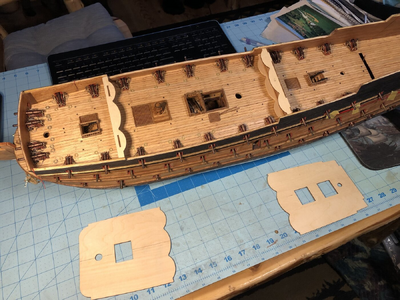
I've used tanganyika wood on two ship model's decks, never thinking the color was inappropriate. In your opinion, what color should the deck be?
This is Tanganyika...looks okay to me.
View attachment 430699
Hi Kurt
No I think it is OK for decks...my complaint is for having to use it as final planking on the hull. ...but I guess I can do some stain/oil experiments first and find a way to do it OK. Your deck looks terrific..well done.
Oh! I see. Yes, Tanganyika is light for hull planking, unless you are making a model and want t he color scheme "painting with wood", and use Tanganyika to represent white or light colored portions of the model. But, then again, for white areas, holly wood would be a better choice. Some woods, like pear, are hard to obtain in the USA, but American walnut, cherry, maple, and red oak are plentiful. As a result, I had to use cherry wood for the sides of the hull on my current model, because the speckled and cross grained stripes of mahogany and sapelle just don't look right to me on a scale model.Hi Kurt
No I think it is OK for decks...my complaint is for having to use it as final planking on the hull. ...but I guess I can do some stain/oil experiments first and find a way to do it OK. Your deck looks terrific..well done.
I seldomly use kit supplied planking. Grab yourself a block of Huon pine and cut your own deck planks.
I debated with myself for a while about replacing the hull and deck wood. However, I needed experience in ship building before spending even more on modifications.... so, I decided to use the supplied wood. It turns out ok (but agree, not easy to work with). The deck wood is indeed darker than the hull, the reason I did some finishing with walnut to balance.
Note: I have little experience with other woods. Here is my current build using Matte poly only.
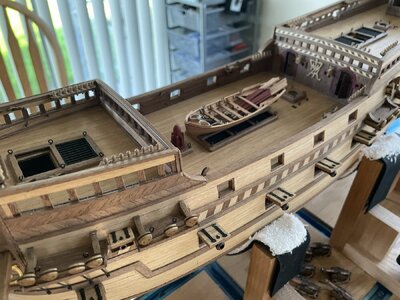
Note: I have little experience with other woods. Here is my current build using Matte poly only.

Last edited:
i would love to do that...that would be sensational. And I have just this week returned from tasmaniaI seldomly use kit supplied planking. Grab yourself a block of Huon pine and cut your own deck planks.
I debated with myself for a while about replacing the hull and deck wood. However, I needed experience in ship building before spending even more on modifications.... so, I decided to use the supplied wood. It turns out ok (but agree, not easy to work with). The deck wood is indeed darker than the hull, the reason I did some finishing with walnut to balance.
Note: I have little experience with other woods. Here is my current build using Matte poly only.
View attachment 430789
Looks great many congratulations


